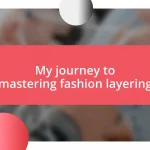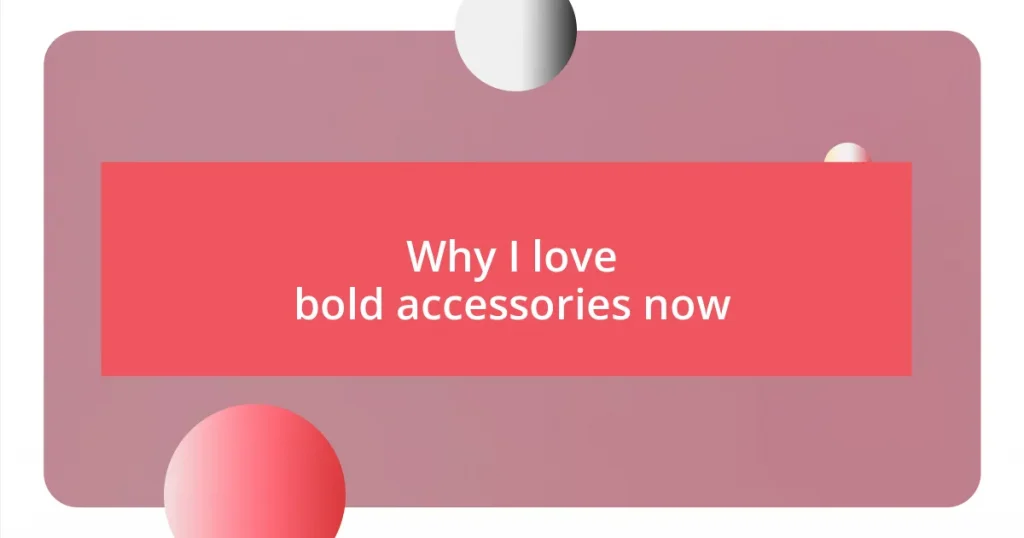Key takeaways:
- DIY fashion projects empower self-expression and creativity, allowing individuals to transform materials into unique personal garments.
- Choosing the right materials is crucial for project success; factors like texture, purpose, and care should be considered.
- Sharing creations through social media or local events fosters community connections and enhances the DIY experience.

Introduction to DIY Fashion Projects
Diving into DIY fashion projects opens a world of creativity, where you can transform basic fabrics into unique pieces that reflect your personal style. I still remember the excitement I felt when I turned an old pair of jeans into a trendy bag; it was like unlocking a hidden talent. Have you ever thought about how empowering it is to wear something that you made with your own hands?
There’s something incredibly rewarding about seeing your vision come to life through DIY. I recall scouring thrift stores for vintage finds to revamp; each piece had a story, and reimagining them was like giving them a new lease on life. It’s these small projects that can spark joy and foster a sense of accomplishment in ways that ready-made clothes often can’t.
Moreover, DIY projects allow for self-expression in a world where trends can sometimes feel overwhelming. I’ve found that creating my own wardrobe helps me step away from the fashion rat race. Have you experienced that freedom when designing your clothes? It’s liberating to make choices that are entirely yours! Each project becomes more than just a task—it evolves into a journey of exploration and personal growth.
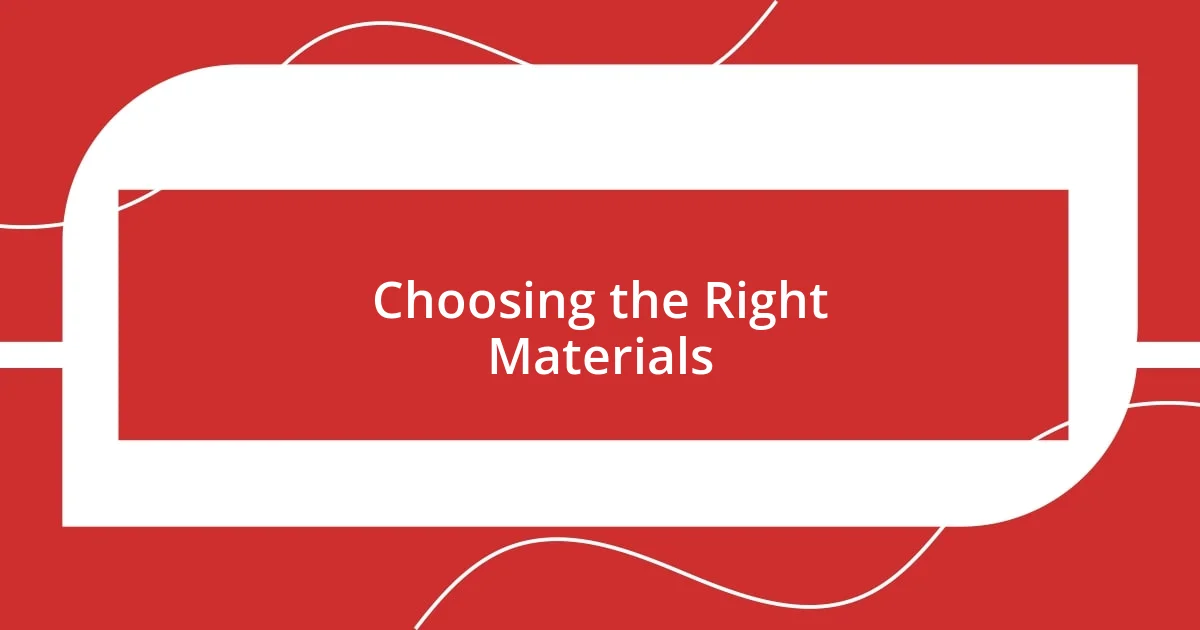
Choosing the Right Materials
Choosing the right materials can make or break your DIY fashion project. I learned this the hard way when I excitedly picked a beautiful fabric online, only to realize it wasn’t suitable for the design I had in mind. It’s vital to consider the texture, weight, and drape of the fabric. Each of these factors plays a significant role in how your finished piece will look and feel.
Here are some tips to keep in mind when selecting materials:
- Purpose: Think about the final use of the item. Is it an everyday outfit or something for a special occasion?
- Texture: Feel the fabric. Does it feel right against your skin? Comfort is key.
- Care: Consider how much maintenance you’re willing to undertake. Some fabrics require special care that might not fit your lifestyle.
- Budget: Stay within your budget but also consider the longevity of the materials. Sometimes, investing a bit more pays off in the end.
- Sourcing: Check local fabric stores or online sites for a variety of options, ensuring you choose materials that inspire you.
I recall being in a fabric store, overwhelmed by the options. I ended up wandering around, letting my fingers glide over a range of textures, which sparked a myriad of ideas. Ultimately, listening to my instincts led me to a fabric that lended itself beautifully to my vision. The right materials not only inspire creativity but also make the sewing process so much more enjoyable.

Step by Step Project Guide
I’ve found that breaking down a DIY fashion project into manageable steps makes the process not only easier but also more enjoyable. For instance, when I designed a simple wrap skirt, I started by sketching my ideas. This visual representation helped clarify my vision. Next, I made a list of essential supplies, which I always find crucial to avoid mid-project scrambles. Finally, I approached the sewing process in stages: cutting, sewing, and finishing. It’s amazing how ticking off each step gives a sense of progress and enthusiasm!
For me, taking photos during each stage is incredibly fulfilling. It captures the growth of the piece and provides a timeline that I can later look back on. I remember feeling a rush of pride when I finally tried on that wrap skirt; it was a reflection of my creativity and effort. Each step not only contributes to the final product but also creates lasting memories of the entire process.
Utilizing a checklist is another technique that I swear by! I often draft one and hang it nearby while I work, which helps keep me focused. I’ve noticed that checking off completed tasks stimulates a little celebratory moment in my mind—it’s those small victories that keep my motivation high. I truly believe that a step-by-step approach can transform your project from a daunting challenge into an engaging journey.
| Step | Description |
|---|---|
| 1. Ideation | Sketch your ideas to clarify your vision. |
| 2. Supplies | Create a list of materials needed for the project. |
| 3. Cutting | Carefully cut the fabric according to your pattern. |
| 4. Sewing | Sew the pieces together, following your plan step by step. |
| 5. Finishing | Add final touches and inspect for quality. |

Tips for Customizing Your Wardrobe
When it comes to customizing your wardrobe, think about incorporating personal touches that reflect your unique style. I remember the day I decided to turn a plain white t-shirt into something special. With just a bit of fabric paint and some stencils, I transformed it into a statement piece. Each time I wear it, I can’t help but smile, knowing that it’s a true testament to my creativity. Isn’t it amazing how a simple modification can elevate an everyday item?
Consider mixing and matching different elements for a fresh look. I often pull together pieces from various outfits to create something brand new. Last summer, I paired an oversized vintage blazer with a floral sundress. The unexpected combination made me feel vibrant and daring, and it sparked conversations wherever I went. Have you ever thought about how a little experimentation could unleash new style ideas hiding in your closet?
Don’t underestimate the power of embellishments! Adding something like lace trim or patches can breathe new life into an old garment. After finding some intricate lace at a craft store, I decided to adorn the hem of an old skirt. The result was stunning—it felt like I wore a piece of art rather than just clothing. It’s about finding joy in the process and celebrating what you create, don’t you agree?

Common Mistakes to Avoid
One common mistake I see often is diving headfirst into a project without proper planning. I remember a time when I eagerly started customizing a pair of jeans without thinking through the design first. As I reached for my scissors, I realized I had no clear vision or even enough fabric for my ideas. Planning ahead might seem tedious, but it ultimately saves you from frustration and wasted materials down the line.
Another frequent pitfall is underestimating the importance of selecting the right materials. I once picked a beautiful fabric that I fell in love with at first sight, only to discover it was far too thick for the delicate blouse I wanted to create. It was a hard lesson learned. Always consider the type of fabric you need for your intended design; the right materials can make or break your project and ensure that the final piece matches your vision.
Lastly, many DIY enthusiasts rush through the finishing touches. I’ve been guilty of this too! I remember when I hastily hemmed a dress, believing it was good enough, only to later notice uneven lines that left me feeling disappointed. Those little details matter. Taking the extra time to refine and perfect your work can transform a decent project into something truly remarkable. Careful attention can enhance your garment and give you a sense of satisfaction every time you wear it. Have you ever felt that sense of pride when everything just clicks?
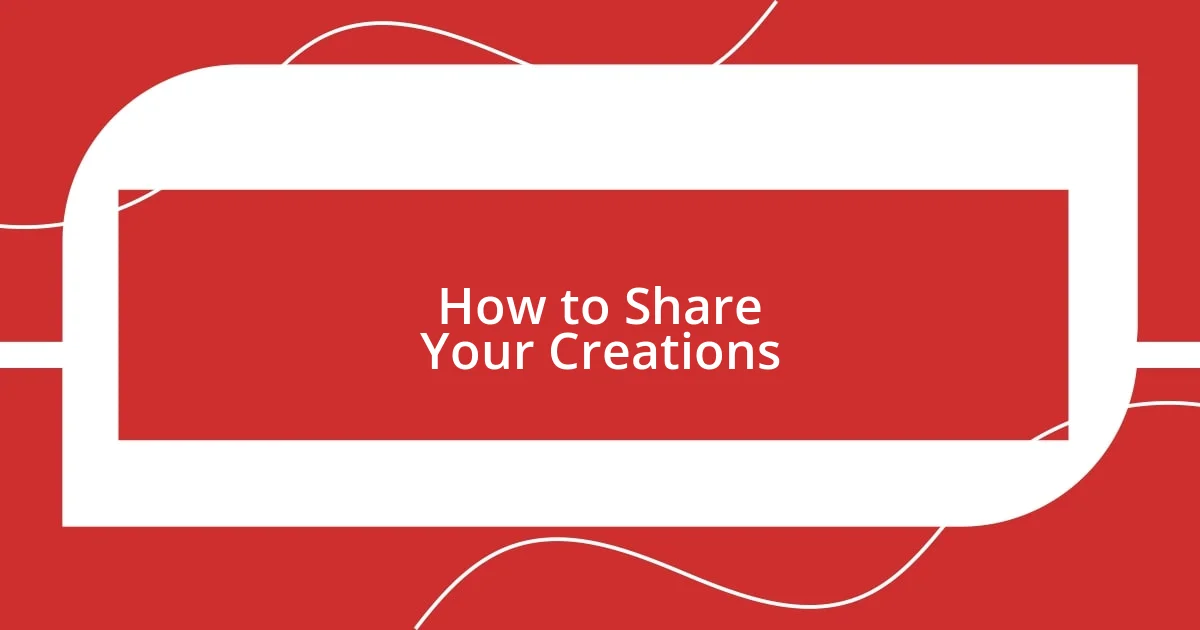
How to Share Your Creations
Sharing your DIY fashion creations can be one of the most rewarding parts of the process. I remember the first time I posted a photo of my hand-painted jacket on social media. The response was overwhelming! Friends and strangers alike reached out to compliment my work, and it felt like a rush of encouragement. Have you ever experienced that moment when someone appreciates your creative efforts? It’s incredibly gratifying.
Consider creating a dedicated space online to showcase your designs. When I started a blog, it transformed my approach to sharing. I began documenting not just the finished pieces, but also the journey—including the trials, errors, and triumphs along the way. This transparency helped others relate to my experiences, and it sparked conversations about DIY techniques and inspirations. Would you believe how much more connected I felt with fellow crafters simply by sharing my journey?
Another effective way to share is through local events or craft fairs. I participated in a community market where I displayed some of my upcycled clothing. It was nerve-wracking but exhilarating to see people interact with my creations in real life. The feedback was invaluable; it opened my eyes to new ideas and collaborations. Have you thought about stepping out of your comfort zone to connect with other creators in person? It can lead to unexpected friendships and creative partnerships!
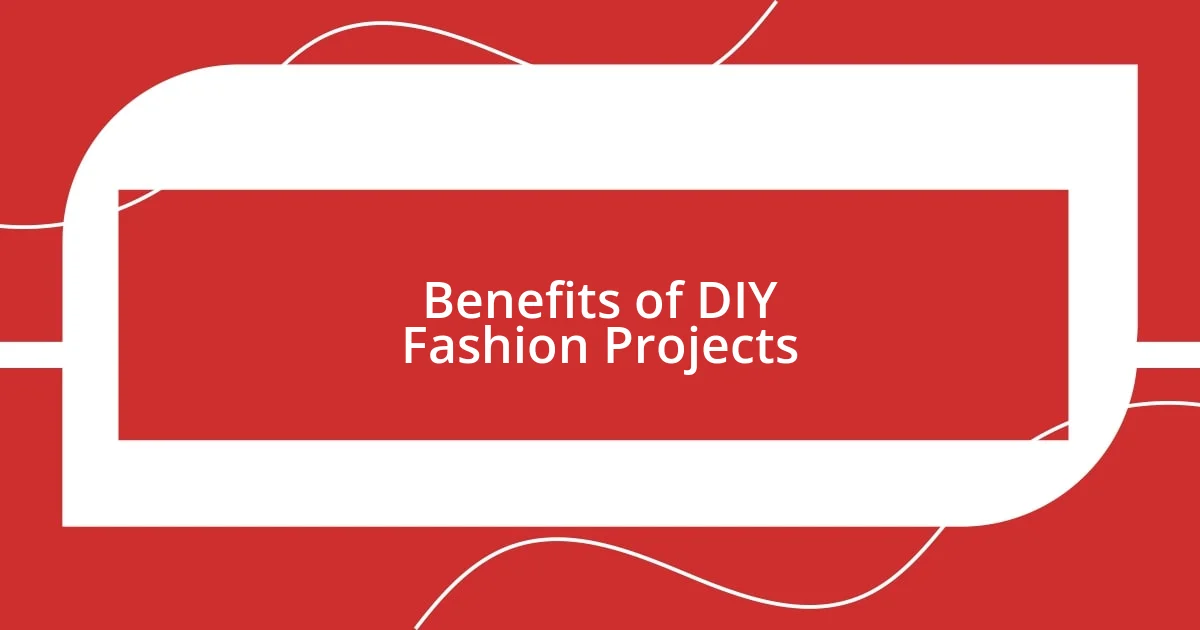
Benefits of DIY Fashion Projects
Engaging in DIY fashion projects brings numerous benefits that can truly enrich your creative journey. First and foremost, there’s a genuine sense of accomplishment that comes from creating something with your own hands. I vividly remember the thrill of finishing my first handmade bag; it was a blend of frustration and joy, but ultimately, holding that unique piece ignited a newfound confidence in my abilities. Have you felt that exhilaration when you realize your creativity has just borne fruit?
Another striking advantage is the opportunity for personal expression. When working on DIY projects, I can customize every detail to reflect my style and personality. I often find that the pieces I create resonate with me in a way that store-bought items never could. For instance, I once transformed an old sweater into a cozy crop top that became my go-to winter outfit. Every time I wear it, it tells a story that feels entirely mine. Isn’t it empowering to wear something that truly represents who you are?
Lastly, DIY fashion projects can be an incredibly cost-effective way to build a unique wardrobe. When I began refurbishing second-hand clothes, I was amazed at how far my budget stretched. One memorable project involved reworking a thrifted denim jacket into a statement piece with patches and embroidery. Not only did I save money, but I also crafted a jacket that no one else had—a special blend of my resources and creativity. Have you ever thought about how much you could save while fostering your inner artist?









